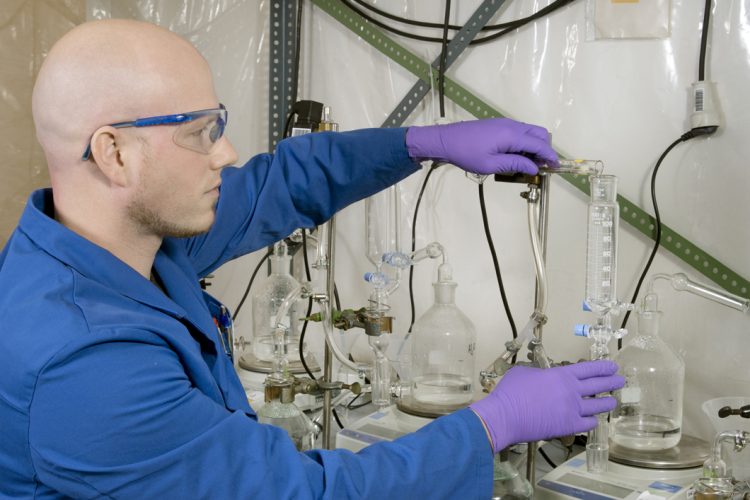How good is the measurement method? Three more interlaboratory tests on safety of chemicals

UN Test N.5 Test apparatus to evaluate gas evolution Source: BAM
The properties of hazardous substances and dangerous goods must be known in order to be able to assess the risks involved in their proper handling. To do this, test methods have been developed which are applied globally; however, many of the method descriptions are ambiguous. “We need to know exactly how good the method is that is used to classify dangerous goods or hazardous substances.
One can certainly choose simple methods with large error limits, but these errors must be known and communicated. This would allow safety professionals to be able to assess test results correctly and make well-founded decisions,” says Dr. Peter Lüth, scientist in Division 2 Chemical Safety Engineering of BAM, who is the responsible head of the interlaboratory test program.
Mr Lüth launched the first interlaboratory test for the classification of the physical hazards of chemicals 10 years ago. A success story because today around 90 laboratories participate in these interlaboratory tests worldwide. BAM, PTB and QuoData GmbH Quality & Statistics have now established a common centre of excellence for quality assurance, CEQAT-DGHS, for testing dangerous goods and hazardous substances.
Three new interlaboratory tests for methods validation are currently being prepared and will be carried out in 2017 to 2018. These are test methods for corrosion to metals (UN Test C.1), for substances which in contact with water emit flammable gases (UN Test N.5) and determination of the lower explosion limit of gases.
“Interlaboratory tests can show how suitable the method is and whether all laboratories come to the same result. Relying only on the experience of a single analyst, does not mean that the measurements are correct. Controlling capabilities through training, education, reference materials or interlaboratory tests, quality assurance of workflows helps to detect and avoid errors. Thus, we create high safety standards in technology and chemistry”, says Lüth.
Laboratories that specialise in these tests are invited to participate in the interlaboratory tests. You can check the details and register to participate in the interlaboratory tests at the CEQAT-DGHS website (see www.ceqat-dghs.bam.de ).
Contact:
Bundesanstalt für Materialforschung und -prüfung (BAM)
Venio Quinque, M.A., LL.M./LL.B.
Head of Section Corporate Communications
Phone: + 49 30 8104-1002
presse@bam.de
www.bam.de
About BAM
BAM promotes safety in technology and chemistry.
As a BMWi departmental research establishment BAM performs research, testing and offers advisory support to protect people, the environment and material goods. Its activity in the fields of materials science, materials engineering and chemistry is focussed on the technical safety of products and processes. BAM’s research is directed towards substances, materials, building elements, components and facilities as well as natural and technical systems important for the national economy and relevant to society. It also tests and assesses their safe handling and operation. BAM develops and validates analysis procedures and assessment methods, models and necessary standards and provides science-based services for the German industry in a European and international framework.
Safety creates markets
BAM sets and represents high standards for safety in technology and chemistry for Germany and its global markets to further develop the successful German “Made in Germany“ quality brand.
For more information see www.bam.de
Media Contact
More Information:
http://www.bam.deAll latest news from the category: Life Sciences and Chemistry
Articles and reports from the Life Sciences and chemistry area deal with applied and basic research into modern biology, chemistry and human medicine.
Valuable information can be found on a range of life sciences fields including bacteriology, biochemistry, bionics, bioinformatics, biophysics, biotechnology, genetics, geobotany, human biology, marine biology, microbiology, molecular biology, cellular biology, zoology, bioinorganic chemistry, microchemistry and environmental chemistry.
Newest articles

First-of-its-kind study uses remote sensing to monitor plastic debris in rivers and lakes
Remote sensing creates a cost-effective solution to monitoring plastic pollution. A first-of-its-kind study from researchers at the University of Minnesota Twin Cities shows how remote sensing can help monitor and…

Laser-based artificial neuron mimics nerve cell functions at lightning speed
With a processing speed a billion times faster than nature, chip-based laser neuron could help advance AI tasks such as pattern recognition and sequence prediction. Researchers have developed a laser-based…

Optimising the processing of plastic waste
Just one look in the yellow bin reveals a colourful jumble of different types of plastic. However, the purer and more uniform plastic waste is, the easier it is to…



